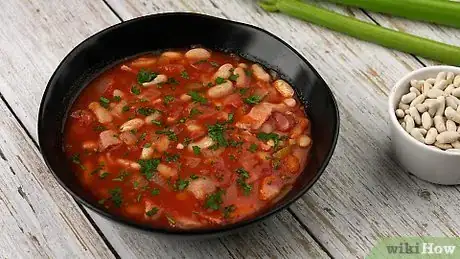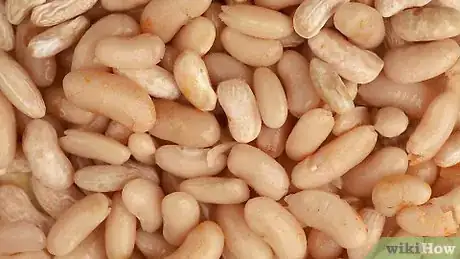This article was co-authored by wikiHow Staff. Our trained team of editors and researchers validate articles for accuracy and comprehensiveness. wikiHow's Content Management Team carefully monitors the work from our editorial staff to ensure that each article is backed by trusted research and meets our high quality standards.
There are 8 references cited in this article, which can be found at the bottom of the page.
The wikiHow Culinary Team also followed the article's instructions and verified that they work.
This article has been viewed 118,664 times.
Learn more...
Navy beans are a common type of bean native to the Americas. They are small, dry, white, and have a somewhat flattened oval shape.Popular preparations for navy beans include baked bean dishes, pies, and soups. Additionally, eating navy beans can help lower your cholesterol. They are rich in nutrients like ferulic acid and p-coumaric acid, and they have cancer fighting properties as well.[1]
Ingredients
- 1 lb (.45 kg) of dry navy beans
- 1 small onion
- 1 stalk celery
- Several cloves garlic
- Olive oil
- Tomatoes (romas or cherry tomatoes; canned chopped ones are also OK)
- Few slices of pancetta or bacon (optional)
Steps
Readying Your Beans
-
1Pick out bad beans. Mixed in with your dry navy beans may be stones or discolored kernels . Discoloration is usually a sign that the bean isn't fit for consumption, so you should remove these along with stones from the good beans.
- Canned navy beans can be prepared more easily than dry beans. You'll only have to cook these lightly for a short time with your ingredients and then the beans will be ready for eating.[2]
- For the purposes of providing a guided example, the process of making navy beans on the stove top is provided. However, you may find making your beans in a slow cooker to be a preferred method.
-
2Rinse your beans. Get a large pot or bowl and place the good beans inside of it. Then run cold water over the beans to remove any impurities or bacteria from the surface of the beans. When you've finished this, you can use a strainer to remove the dirty water from the beans in your bowl/pot.[3]Advertisement
-
3Prepare the dried navy beans by soaking them. Put your rinsed beans back into the bowl/pot and cover them completely with cold water. For every pound (.45 kg) of beans, you should use eight cups of cold water. Then allow the beans to soak for a minimum of eight hours or overnight.
- When you soak navy beans, enzymes inside the bean are broken down. This will decrease gas.
-
4Simmer your beans until tender. First you'll need to strain your beans from the cold water they've been soaking in. Then put the beans into a pot and cover them with six cups of hot water for every pound (.45 kg) of beans. Turn on your stove and bring the water to a boil and then simmer the beans for 1.5 to 2 hours.
- You can adjust the time you simmer your beans to adjust the tenderness of your beans. Shorter simmer times will yield firmer beans, longer times will result in more tender beans.
- While simmering, it's likely a foam will form on the top of your water. Add 1 - 2 tablespoons of butter or olive oil to the water to cut down on foam.
- Wait until the beans are completely cooked before adding any salt. Adding salt earlier interferes with the re-hydration process and can result in "tough" beans.
-
1Chop up your ingredients. Use a sharpened knife to cut a small onion, stalk of celery, several cloves of garlic, and tomatoes. These will be used to give flavor and variety in your simple navy bean dish. You can cut up these ingredients very finely to create a smoother consistency, or you could leave larger pieces for a chunkier end result.
- Roma tomatoes or cherry tomatoes work well in this dish. Heirloom tomatoes can add a delicious, rich flavor to it.[4]
-
2Mix in some pancetta or chopped bacon. All you need is a few slices for your dish, though if you're a fan of this kind of meat, you can always add more. If you're not a fan of pancetta or bacon, you could add chopped chicken or sausage.
- Whatever meat you add, be sure you saute it until it is cooked throughout. Thicker, chunkier pieces of meat will require more time than thin pieces.
-
3Saute the onion, celery, and garlic in olive oil. Coat your saucepan with a thin layer of olive oil. Then turn on your stove top and set it to a medium-high heat. Add your onion, celery, and garlic to the pan and allow the ingredients to cook for 3 - 5 minutes.[5]
- Continue cooking your ingredients, lowering the heat if necessary, until the onions and bacon are well browned.[6]
- If you notice your garlic start to brown, turn your heat down or begin the next phase of this dish. When cooked too long/burned, garlic can become bitter.
-
4Add your tomato(es). These will cook down in the heat of your pan. The tomato juice and flavor will also infuse through the rest of your dish. You can also create more nuanced flavors by adding spices and seasonings, like rosemary or thyme.[7]
-
1Add the beans. By cooking your beans with your ingredients, the beans will take on the flavor of the dish. This will only take about a minute or so. After a minute has passed, if you want to further tenderize your beans, you should add enough water to cover the beans with at least an inch (2.5 cm) of water.[8]
- You can add as many or as few beans as you desire to this dish.
-
2Simmer the beans and other ingredients, if necessary. If your beans are already cooked to your desired tenderness, you might not want to re-simmer the beans with the ingredients for very long. However, for further tenderness, you should first bring your ingredients to a boil. Then lower the heat until the mixture is at a simmer and allow it to simmer until the beans are tender.
- During this process, you may need to add water to the mixture if you notice it getting too low.[9]
-
3Garnish and serve your navy beans. When the beans are tender they are ready to serve. You may want to add some accents to the dish to improve its presentation. You can do this by topping it with some freshly chopped parsley, or even a sprig of parsley.
-
4Try other navy bean recipes. There are many ways you can prepare your navy beans. With 15 minutes of prep time and about 4½ hours of slow simmering, you could make homemade navy bean soup.[10] Pork is a popular accent meat for navy beans, and you might consider making ham hocks with your navy beans in a slow cooker.[11]
- Many recipes are available online for free. To explore more options for navy bean recipes, you should try doing a keyword search for "navy bean recipes."
Community Q&A
-
QuestionCan I start to cook the beans after they have sorted?
 Francois CoeurCommunity AnswerYes, but you want to make sure both sets of beans are soft before you mix them together, and they need to be cleaned off before cooking. Simmering beans give them a delicate but moist taste.
Francois CoeurCommunity AnswerYes, but you want to make sure both sets of beans are soft before you mix them together, and they need to be cleaned off before cooking. Simmering beans give them a delicate but moist taste. -
QuestionCould I also bake these white navy beans?
 Community AnswerYou could, but they would still need to be cooked or at least parcooked first.
Community AnswerYou could, but they would still need to be cooked or at least parcooked first. -
QuestionWhy are my navy beans bitter?
 Community AnswerPossibly because of the way you prepared them. Be sure they soak and then cook long enough, and don't be afraid to taste-test and adjust your seasoning accordingly.
Community AnswerPossibly because of the way you prepared them. Be sure they soak and then cook long enough, and don't be afraid to taste-test and adjust your seasoning accordingly.
Things You'll Need
- Large bowl for soaking
- Colander
- Cooking pot
- Spatula or cooking spoon
- Serving plates
- Knife
References
- ↑ http://www.whfoods.com/genpage.php?tname=foodspice&dbid=88
- ↑ http://www.whfoods.com/genpage.php?tname=foodspice&dbid=88
- ↑ http://www.thekitchn.com/how-to-cook-beans-in-the-slow-cooker-74529
- ↑ http://allrecipes.com/recipe/13102/bean-with-bacon/?internalSource=hn_carousel%2001_Bean%20with%20Bacon%20Soup&referringId=17027&referringContentType=recipe%20hub&referringPosition=carousel%2001
- ↑ http://allrecipes.com/recipe/13102/bean-with-bacon/?internalSource=hn_carousel%2001_Bean%20with%20Bacon%20Soup&referringId=17027&referringContentType=recipe%20hub&referringPosition=carousel%2001
- ↑ http://www.dinnerwithjulie.com/recipe/white-beans-with-tomatoes-spinach-and-pancetta/
- ↑ http://abc.go.com/shows/the-chew/recipes/braised-white-beans-sofrito-mario-batali
- ↑ http://www.thekitchn.com/how-to-cook-beans-in-the-slow-cooker-74529
- ↑ http://allrecipes.com/recipe/13102/bean-with-bacon/?internalSource=hn_carousel%2001_Bean%20with%20Bacon%20Soup&referringId=17027&referringContentType=recipe%20hub&referringPosition=carousel%2001
About This Article
To cook dried navy beans, rinse them off and soak them in cold water for 8 hours or overnight. Next, drain the beans and place them in a large pot. Then, cover the beans with water and simmer them for 1.5 to 2 hours. While the beans are simmering, chop up the onion, celery, garlic, and tomatoes and saute them in a separate skillet. Finally, add the sauteed veggies to the simmering beans and remove the pot from the heat once the beans get tender. For tips on adding bacon or pancetta to the dish, read on!























































